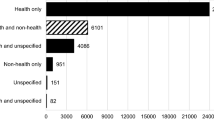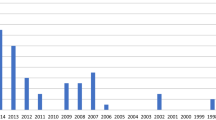Abstract
The study investigated the participation of so-called ‘international national organisations’ (INOs) in agricultural and health research in Zimbabwe, a country in southern Africa. An INO refers to an international organisation or an initiative of an international organisation that uses an African country address in its publications. A first objective was to develop a classification of authorship types that accommodates the phenomenon of INOs as a form of international participation next to international co-authorship. A second objective was to apply the framework to the research output of Zimbabwe in the period 1980–2016, to determine whether changes in authorship types, and also INO participation, coincide with changes in the country’s socio-economic context. The dataset was compiled by integrating relevant Zimbabwean articles from Scopus and Web of Science. It comprised 10,753 articles across all fields, of which 2091 were in agriculture and 4353 in health. The results showed that, in the period 2009–2016, 36% of articles in agriculture involved an INO. The corresponding figure for health was 15%. Participation by INOs rarely occurred without any international co-authorship also being present. A visualization of the location of INOs in author research networks revealed a small number of INO authors occupying prominent spaces in the networks for agriculture and health, with the INO authors being of different kinds (e.g. ‘INO only affiliated authors’ vs. ‘INO affiliated authors with other local and foreign affiliations’). It is concluded that relatively small tailor-made bibliometric datasets, developed for African countries with small science systems, have the potential to produce new insights and frameworks to direct future studies on research in Africa.






Similar content being viewed by others
References
Adams, J., Gurbey, K., & Hook, D. (2014). International collaboration clusters in Africa. Scientometrics,98(1), 547–556.
ADB-OECD-UNDP. (2014). African economic outlook 2014. Global value chains and Africa’s industrialisation. Report by the African Development Bank, Organisation for Economic Co-operation and Development and United Nations Development Programme. Retrieved January 2, 2019, from www.africaneconomicoutlook.org/en.
AU-NEPAD. (2010). African innovation outlook 2010. Pretoria: African Union-New Partnership for Africa’s Development.
Besada, H., & Moyo, N. (2008). Zimbabwe in crisis: Mugabe’s policies and failures. Working paper No. 38. Retrieved November 22, 2018, from www.cigionline.org.
Boshoff, N. (2009). Neo-colonialism and research collaboration in Central Africa. Scientometrics,81(2), 413–434.
Boshoff, N. (2010). South-South research collaboration of countries in the Southern African Development Community (SADC). Scientometrics,84(2), 481–503.
Chen, K., Zhang, Y., & Fu, X. (2019). International research collaboration: An emerging domain of innovation studies? Research Policy,48(1), 149–168.
Chimboza, A. (2012). From brain drain to brain gain: Addressing human capital needs for post crisis Zimbabwe’s capacity building. Master of Philosophy Thesis. Retrieved September 22, 2017, from http://repository.upenn.edu/od_theses_mp/11.
Delisle, H., Roberts, J. H., Munro, M., Jones, L., & Gyorkos, T. W. (2005). The role of NGOs in global health research for development. Health Research Policy and Systems,3(1), 3.
Dodsworth, S. (2019). The challenges of making research collaboration in Africa more equitable. Oxford Research Encyclopedia of Politics. https://doi.org/10.1093/acrefore/9780190228637.013.1389.
EGPAF. (2020). The Elizabeth Glaser Pediatric Aids Foundation. Retrieved February 28, 2020, from https://www.pedaids.org/focus/our-programs/.
Herdt, R. W. (2012). People, institutions, and technology: A personal view of the role of foundations in international agricultural research and development 1960–2010. Food Policy,37(2), 179–190.
Hodgkinson, D., & Pasirayi, P. (2015). Zimbabwe’s research and knowledge system: Literature review and analysis. Retrieved August 27, 2017, from https://www.inasp.info/sites/default/files/Country%20profile%20%E2%80%93%20Zimbabwe.
Ishengoma, J. M. (2016a). North-South research collaborations and their impact on capacity building: A Southern perspective. In T. Halvorson & J. Nossum (Eds.), North-South knowledge networks. Towards equitable collaboration between academics, donors and universities (pp. 149–186). African Minds: South Africa.
Ishengoma, J. M. (2016b). Strengthening higher education space in Tanzania through North-South partnerships and links: Experiences from the University of Dar es Salaam. Comparative & International Education,45(1), 1–17.
Jamil, I., & Haque, S. T. M. (2016). Knowledge generation through joint research: What can North and South learn from each other? In T. Halvorson & J. Nossum (Eds.), North-South knowledge networks. Towards equitable collaboration between academics, donors and universities (pp. 239–276). South Africa: African Minds.
Kozma, C., Medina, C. C., & Costas, R. (2018). Research funding landscapes in Africa. In C. Beaudry, J. Mouton, & H. Prozesky (Eds.), The next generation of scientists in Africa (pp. 26–42). South Africa: African Minds.
Landini, F., Malerba, F., & Mavilia, R. (2015). The structure and dynamics of networks of scientific collaborations in Northern Africa. Scientometrics,105(3), 1787–1807.
Mêgnigbêto, E. (2013). International collaboration in scientific publishing: The case of West Africa (2001–2010). Scientometrics,96(3), 761–783.
Mlambo, A. S. (2005). Postcolonial higher education in Zimbabwe: The University of Zimbabwe as a case study 1980–2004. African Historical Review,37(1), 107–130.
Mouton, J. (2018). African science: A diagnosis. In C. Beaudry, J. Mouton, & H. Prozesky (Eds.), The next generation of scientists in Africa (pp. 3–12). South Africa: African Minds.
Mouton, J., & Blanckenberg, J. (2018). African science: A bibliometric analysis. In C. Beaudry, J. Mouton, & H. Prozesky (Eds.), The next generation of scientists in Africa (pp. 13–25). South Africa: African Minds.
Mouton, J., Boshoff, N., De Waal, L., Esau, S., Imbayarwo, B., Ritter, M., et al. (2008). The state of public science in the SADC region. In P. Kotecha (Ed.), Towards a common future: Higher education in the SADC region Research findings from four SARUA studies. Johannesburg: Southern African Regional Universities Association.
Ng’ethe, N. (1991). In search of NGOs: Towards a funding strategy to create NGO research capacity in Eastern and Southern Africa (No. 58). Institute for Development Studies, University of Nairobi.
Owusu-Nimo, F., & Boshoff, N. (2017). Research collaboration in Ghana: Patterns, motives and roles. Scientometrics,110(3), 1099–1121.
Pouris, A., & Ho, Y.-S. (2014). Research emphasis and collaboration in Africa. Scientometrics,98(3), 2169–2184.
Schubert, T., & Sooryamoorthy, R. (2010). Can the centre–periphery model explain patterns of international scientific collaboration among threshold and industrialised countries? The case of South Africa and Germany. Scientometrics,83(1), 181–203.
Sooryamoorthy, R. (2009). Science and scientific collaboration in South Africa: Apartheid and after. Scientometrics,84(2), 373–390.
Terry, R. F., & Van der Rijt, T. (2010). Overview of research activities associated with the World Health Organization: Results of a survey covering 2006/07. Health Research Policy and Systems,8(1), 8–25.
UNESCO. (2014). Mapping research and innovation in the Republic of Zimbabwe. Retrieved June 27, 2017, from file:///C:/Users/19655118/Downloads/GO-Spin-%20Zimbabwe%20report%20(1).pdf.
UNESCO. (2015). UNESCO science report. Towards 2030. Retrieved October 23, 2018, from https://en.unesco.org/unesco_science_report.
United Nations. (2015). Resolution adopted by the General Assembly on 25 September 2015. Washington: United Nations.
Zogbo, J. R. (2003). The impact of the economic structural adjustment programme on education in Zimbabwe. Retrieved January 27, 2019, from https://opendocs.ids.ac.uk.
Acknowledgements
This work is based on the research supported by the National Research Foundation (NRF) of South Africa (Grant No. 91488). Any opinion, finding and conclusion or recommendation expressed in this article is that of the authors and the NRF does not accept any liability in this regard.
Author information
Authors and Affiliations
Corresponding author
Rights and permissions
About this article
Cite this article
Ngwenya, S., Boshoff, N. Participation of ‘international national organisations’ in Africa’s research: a bibliometric study of agriculture and health in Zimbabwe. Scientometrics 124, 533–553 (2020). https://doi.org/10.1007/s11192-020-03480-y
Received:
Published:
Issue Date:
DOI: https://doi.org/10.1007/s11192-020-03480-y




